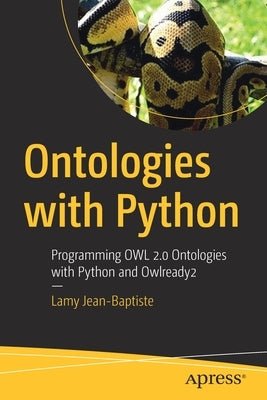Description
Chapter 1: Introduction1. Who is this book for?2. Why ontologies?3. Why Python?4. Why Owlready?5. Book outline6. Acknowledgements
Chapter 2: Python Language: Adopt a Snake! 1. Installing Python2. Starting Python3. Syntax 4. Main datatypes5. Conditions (if)6. Loops (for) 7. Generators8. Functions (def) 9. Classes (class) 10. Python modules11. Installing Owlready212. Summary
Chapter 3: OWL Ontologies 1. An ontology... what does it look like?2. Creating ontologies manually with the Protégé editor3. Example: An ontology of bacteria4. Creating a new ontology- Classes- Disjoints- Partitions - Data properties- Object properties - Restrictions - Union, intersection, and complement- Definitions (equivalent to relations)- Individuals - Other constructs 5. Automatic reasoning6. Modeling exercises7. Summary
Chapter 4: Accessing Ontologies in Python 1. Importing Olwready2. Loading an ontology 3. Imported ontologies4. Listing the content of the ontology 5. Accessing to entities - Individuals - Relations - Classes- Existential restrictions - Properties 6. Searching for entities 7. Huge ontologies and disk cache 8. Namespaces 9. Modifying entity rendering as text 10. Local directory of ontologies 11. Reloading an ontology in the quadstore 12. Example: Creating a dynamic website from an ontology13. Summary
Chapter 5: Creating and Modifying Ontologies in Python 1. Creating an empty ontology 2. Creating classes 3. Creating properties 4. Creating individuals 5. Modifying entities: Relations and existential restrictions6. Creating entities within a namespace7. Renaming entities (refactoring)8. Multiple definitions and forward declarations9. Destroying entities 10. Destroying an ontology11. Saving an ontology12. Importing ontologies 13. Synchronization 14. Example: Populating an ontology from a CSV file15. Summary
Chapter 6: Constructs, Restrictions, Class Properties 1. Creating constructs 2. Accessing constructs parameters 3. Restrictions as class properties 4. Defined classes 5. Example: Creating the ontology of bacteria in Python6. Example: Populating an ontology with defined classes7. Summary
Chapter 7: Automatic Reasoning 1. Disjoints 2. Open-world assumption3. Reasoning in a closed world, or in a local closed world4. Inconsistent classes and inconsistent ontologies5. Restriction and reasoning on numbers and strings 6. SWRL rules 7. Example: An ontology-based decision support system8. Summary
Chapter 8: Annotations, Multilingual Texts and Full Text Search 1. Annotating entities2. Multilingual texts3. Annotating constructs4. Annotating properties and relations 5. Creating new annotation classes
Author: Lamy Jean-Baptiste
Publisher: Apress
Published: 01/17/2021
Pages: 344
Binding Type: Paperback
Weight: 1.12lbs
Size: 9.21h x 6.14w x 0.75d
ISBN13: 9781484265512
ISBN10: 1484265513
BISAC Categories:
- Computers | Internet | Web Programming
- Computers | Languages | Python
Chapter 2: Python Language: Adopt a Snake! 1. Installing Python2. Starting Python3. Syntax 4. Main datatypes5. Conditions (if)6. Loops (for) 7. Generators8. Functions (def) 9. Classes (class) 10. Python modules11. Installing Owlready212. Summary
Chapter 3: OWL Ontologies 1. An ontology... what does it look like?2. Creating ontologies manually with the Protégé editor3. Example: An ontology of bacteria4. Creating a new ontology- Classes- Disjoints- Partitions - Data properties- Object properties - Restrictions - Union, intersection, and complement- Definitions (equivalent to relations)- Individuals - Other constructs 5. Automatic reasoning6. Modeling exercises7. Summary
Chapter 4: Accessing Ontologies in Python 1. Importing Olwready2. Loading an ontology 3. Imported ontologies4. Listing the content of the ontology 5. Accessing to entities - Individuals - Relations - Classes- Existential restrictions - Properties 6. Searching for entities 7. Huge ontologies and disk cache 8. Namespaces 9. Modifying entity rendering as text 10. Local directory of ontologies 11. Reloading an ontology in the quadstore 12. Example: Creating a dynamic website from an ontology13. Summary
Chapter 5: Creating and Modifying Ontologies in Python 1. Creating an empty ontology 2. Creating classes 3. Creating properties 4. Creating individuals 5. Modifying entities: Relations and existential restrictions6. Creating entities within a namespace7. Renaming entities (refactoring)8. Multiple definitions and forward declarations9. Destroying entities 10. Destroying an ontology11. Saving an ontology12. Importing ontologies 13. Synchronization 14. Example: Populating an ontology from a CSV file15. Summary
Chapter 6: Constructs, Restrictions, Class Properties 1. Creating constructs 2. Accessing constructs parameters 3. Restrictions as class properties 4. Defined classes 5. Example: Creating the ontology of bacteria in Python6. Example: Populating an ontology with defined classes7. Summary
Chapter 7: Automatic Reasoning 1. Disjoints 2. Open-world assumption3. Reasoning in a closed world, or in a local closed world4. Inconsistent classes and inconsistent ontologies5. Restriction and reasoning on numbers and strings 6. SWRL rules 7. Example: An ontology-based decision support system8. Summary
Chapter 8: Annotations, Multilingual Texts and Full Text Search 1. Annotating entities2. Multilingual texts3. Annotating constructs4. Annotating properties and relations 5. Creating new annotation classes
Author: Lamy Jean-Baptiste
Publisher: Apress
Published: 01/17/2021
Pages: 344
Binding Type: Paperback
Weight: 1.12lbs
Size: 9.21h x 6.14w x 0.75d
ISBN13: 9781484265512
ISBN10: 1484265513
BISAC Categories:
- Computers | Internet | Web Programming
- Computers | Languages | Python
About the Author
Lamy Jean-Baptiste is a senior lecturer at Paris 13 University and a member of the LIMICS, a research lab focused on biomedical informatics. He is also the developer of the Owlready2 Python module that allows access to OWL ontologies. He has developed many research prototypes, and one of them (VCM iconic medical language) has been patented in the US, with three licenses sold to industrial partners.
Lamy speaks regularly at artificial intelligence and medical informatics conferences, has written over 50 journal papers, and is a moderator on the Owlready forum on Nabbles. He was awarded the best paper award at MEDINFO 2019, the largest international conference in medical informatics.
